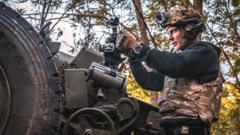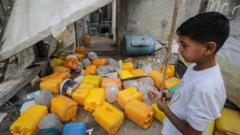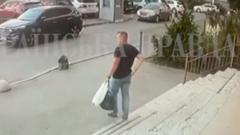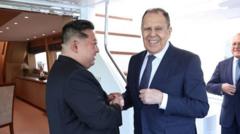General Oleksandr Syrskyi announced that Ukrainian forces have stabilized combat lines in the Sumy region, successfully halting a Russian offensive. However, shortcomings in fortifications pose challenges as the conflict continues to escalate with increasing Russian drone attacks.
Ukrainian Forces Secure Frontline Stabilization Amid Russian Pressures in Sumy

Ukrainian Forces Secure Frontline Stabilization Amid Russian Pressures in Sumy
Ukraine's military head confirms progress in halting Russian advances in Sumy, but challenges remain in fortification efforts.
Ukrainian military chief, General Oleksandr Syrskyi, reported a significant breakthrough for Ukrainian forces in the Sumy region, noting that they have successfully stood firm against a Russian offensive threatening the northeastern border. During his recent visit to the frontline, Syrskyi proclaimed that the combat line had been "stabilized" and characterized the Russian summer offensive in Sumy as having been "choked off."
Despite these advancements, General Syrskyi highlighted the urgent need for enhanced fortifications in the region, acknowledging that he personally inspected existing defenses. He recognized public concerns about the delays in constructing stronger defensive positions in Sumy, which borders Russia's Kursk region. Moreover, reports from Ukrainian officials indicate a declining intensity of Russian pressure in the area, although Border Guard spokesperson Andriy Demchenko warned that the situation remains "volatile."
Historically, the region of Sumy had witnessed a surge of activity from Russian forces, particularly after the incursion of Ukrainian troops into Kursk last year, prompting Moscow to declare plans for "security buffer zones" along its own borders. In late May, Ukraine's President Volodymyr Zelensky reported a build-up of 50,000 Russian troops in the border area, indicating a looming threat to create a 10km (6-mile) buffer zone.
Syrskyi's assurances about ongoing fortifications seek to mitigate growing public anxiety over the apparent lack of defensive structures in critical areas. He outlined tasks being implemented, such as constructing anti-drone corridors and establishing 'kill zones' to bolster troop logistics; nevertheless, he admitted the need for greater efficiency in executing these improvements.
The absence of adequate defenses had previously enabled Russia's advances into Ukrainian territory during the early months of the invasion that began in February 2022. The time of opportunity for construction in the Sumy region was notably in autumn 2024, yet current circumstances may limit Ukraine's capacity to strengthen unprotected front lines. In recent months, Russian forces have claimed victories in several villages while conducting devastating missile strikes on the city of Sumy, resulting in numerous civilian casualties.
Monitoring sources, including the group DeepState, report that fierce combat persists in vulnerable areas of Sumy. Analysts have also pointed out that delays and the substandard quality of dugouts can no longer be overlooked. At a recent forum in St. Petersburg, President Putin commented on the summer offensive, suggesting that while Russia does not aim to capture Sumy, it is a potential outcome, stating that Russian forces have established a buffer zone of 8-12km deep.
As the war enters its fourth year, the situation remains precarious, with escalated drone attacks on Ukrainian cities, including a concerning strategy of overwhelming air defenses in the capital, Kyiv. While recent dialogues between Ukraine and Russia have facilitated prisoner exchanges, a path towards a ceasefire remains elusive. Additionally, NATO Secretary General Mark Rutte revealed that European and Canadian allies contributed €35 billion (£30 billion; $41 billion) to support Ukraine, however, hesitation over U.S. President Donald Trump's commitment to Ukraine’s defense serves as an ongoing point of contention. Trump indicated his discussion with Zelensky at a recent NATO summit was "very nice" and floated the possibility of supplying Kyiv with U.S. Patriot air defense missiles to counter increasing Russian threats.




















